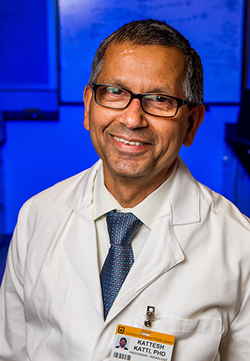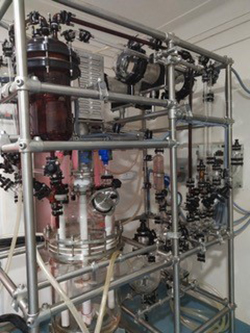
Green nanotechnology developed at the University of Missouri is being studied with the goal of making a traditional form of holistic medicine more effective in fighting cancer. India-based company Dhanvantari Nano Ayushadi (DNA) is using an MU-developed green nanotechnology to explore new treatment options for breast cancer.
Ayurvedic medicine is a form of holistic medicine that uses a combination of chemicals derived from natural herbs, spices, fruits and vegetables, coupled with various metals such as gold, silver and copper. Gold or other alloys predominantly used in holistic medicine have been crushed and burned, and caregivers then grind the ash with herbs to produce an ingestible treatment. However, the ways in which those metals are obtained often involve potentially deadly toxins.

A research team led by Kattesh Katti, PhD, Curators Distinguished Professor of Radiology and Physics in the MU School of Medicine and the MU College of Arts and Science and senior research scientist at the MU Research Reactor (MURR), helped develop green nanotechnologies to produce phytonano medicines, which are compounds that form the basis for Ayurvedic medicine. These green therapies are less toxic to the body and could provide alternatives to current treatments for a variety of diseases.
“Ayurvedic medicine is one of the world’s oldest forms of medications, but it is based on principles that can have a profound effect on how we develop preventive medicine and disease treatments today,” Katti said. “Our technique for producing nanoparticles has been licensed by DNA for the development of next generation treatments and health care products. The company is testing formulas to develop complementary therapies to chemotherapy, radiation and other traditional treatments.”
Katti is also the director of the Institute of Green Nanotechnology. He is globally recognized as the “Father of Green Nanotechnology” for his groundbreaking discoveries in nano-medicine.
C.M. Joshi, MD, a longtime collaborator of Katti’s, is studying the technology at an Ayurvedic medicine hospital in Koppal in southern India. He’s confident early results show promise in harnessing nano-Ayurvedic medicine to combat breast cancer.
“Dr. Katti’s green nanotechnology approaches have provided credible scientific rationale for Ayurvedic medicine,” said Joshi, who serves chief medical officer at DNA. “This is a game-changer for Ayurvedic medicine as I am already seeing excellent efficacies in my patients administered with nano-Ayurvedic medicine drugs in treating a variety of diseases and disorders.”

The technology is patent pending, though the U.S. Patents and Trademarks Office has recently issued a Notice of Allowance to use “Nano Ayurvedic Medicine” as a trademark for various medicinal preparations containing herbs and metals for holistic health purposes. In addition to piloting complementary therapies using nano-Ayurvedic medicine, DNA is also using licensed MU technology to develop new silver-based health care products.
“Our green nanotechnology approach for silver-based antibiotics and anti-infectives has produced a new generation of antimicrobial/antibiotics and anti-fungal products for household use, in hospitals and other health care sectors,” said Deepak Abhaya, general manager of DNA. “Our products decontaminate kitchens, operation theaters and various food particles, thus destroying drug-resistant deadly bacteria, microbes and fatal pathogens.”
“Ayurvedic medicine has been used in India for more than 5,000 years, but it’s currently used by less than 1 percent of the world’s population,” Katti said. “Thanks to the efforts of our team of researchers, I believe this will change and we will be able to bring new options to patients.”





